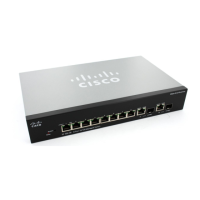Configuring IP Information
Management and IP Interfaces
Cisco Small Business 300 Series Managed Switch Administration Guide 180
15
The following fields are displayed for the neighboring interfaces:
• Interface—Neighboring IPv6 interface type.
• IPv6 Address—IPv6 address of a neighbor.
• MAC Address—MAC address mapped to the specified IPv6 address.
• Type—Neighbor discovery cache information entry type (static or dynamic).
• State—Specifies the IPv6 neighbor status. The values are:
-
Incomplete
—Address resolution is working. The neighbor has not yet
responded.
-
Reachable
—Neighbor is known to be reachable.
-
Stale
—Previously-known neighbor is unreachable. No action is taken to
verify its reachability until traffic must be sent.
-
Delay
—Previously-known neighbor is unreachable. The interface is in
Delay state for a predefined Delay Time. If no reachability confirmation is
received, the state changes to Probe.
-
Probe
—Neighbor is no longer known to be reachable, and Unicast
Neighbor Solicitation probes are being sent to verify the reachability.
STEP 3 Click Add. The Add IPv6 Neighbors Page opens.
The Add IPv6 Neighbors Page
provides information for adding a neighbor to be
monitored.
STEP 4 Enter the values for the following fields:
• Interface—The neighboring IPv6 interface to be added.
• IPv6 Address—Enter the IPv6 network address assigned to the interface.
The address must be a valid IPv6 address.
• MAC Address—Enter the MAC address mapped to the specified IPv6
address.
STEP 5 Click Apply. The switch is updated.
Modifying an IPv6 Neighbor
STEP 1 In Layer 2 mode, click Administration > Management Interface > IPv6
Neighbors.

